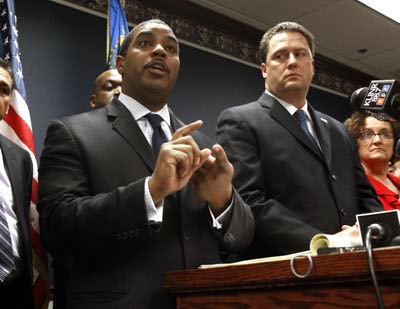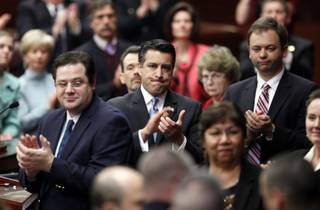
AP Photo/Rich Pedroncelli
Gov. Brian Sandoval acknowledges the applause of lawmakers and guests after entering the Nevada Assembly chambers to deliver his first State of the State speech before a joint session of the Nevada Legislature in Carson City on Monday, Jan. 24, 2011.
Tuesday, Jan. 25, 2011 | 12:22 a.m.
Grade Sandoval's State of the State address
- What grade would you assign to Gov. Brian Sandoval's State of the State address?
- F — 37.2%
- D — 20.2%
- A — 16.6%
- C — 15.5%
- B — 10.5%
- What is your ZIP code?
- What is your political party affiliation?
- Democrat — 45.4%
- Independent — 24.3%
- Republican — 22.4%
- Other — 3.6%
- Libertarian — 2.4%
- Green — 1.1%
- Tea Party of Nevada — 0.7%
- Independent American Party — 0.1%
This poll is closed, see Full Results »
Note: This is not a scientific poll. The results reflect only the opinions of those who chose to participate.
Beyond the Sun
Sun Coverage
Sun Archives
- Scott Dickensheets: Imagine the state of the state two years down the road (1-24-11)
- State of the State: How doors could open for Nevada (1-24-11)
- Is Brian Sandoval’s ‘shared-sacrifice’ budget the solution to state’s economic woes? (1-23-11)
- Most vulnerable await budget cuts with trepidation (1-23-11)
- Increasingly worried liberals seek pushback on Sandoval budget (1-21-11)
- Construction industry: Raise taxes for job growth (1-20-11)
- Groups seek higher taxes on tobacco and gasoline (1-20-11)
- Sandoval warns of consolidation, job losses in state government (1-19-11)
In his first State of the State address, Gov. Brian Sandoval promised short-term fixes to Nevada’s budget crisis and long-term reforms to help the state navigate the economic terrain forever changed by the Great Recession.
With the tone of a father protecting his children from the harshest realities, Sandoval couched the fact that budget cuts will wreak havoc on state services more in euphemisms than stark details. He relied on broad percentages and dollar figures to describe his spending plan.
Rather than detail the services that Nevadans could no longer rely on, he explained his efforts to save the state from the toughest cuts under consideration — suggesting a budget half full, not half empty.
“It’s as if the collective Nevada family has gathered around the table — each member leaning forward in his or her chair, eager to hear the news,” he said during Monday’s hourlong speech.
In it, he worked to build on his image as a thoughtful leader who will take care of the state.
Yet while he asked Nevadans to trust his lead, he also asked them not to look to government, particularly the state budget, to see them through the recession.
“Some believe government is the only solution to our current plight,” he said. “I disagree. Unemployment, foreclosures, bankruptcy — the cure is not more government spending, but helping businesses create jobs.”
In his inaugural address this month, Sandoval promised to fix state government, reform a failing education system and reverse the economic decline within three years.
His road map to get there was unveiled Monday. It includes directing some government spending toward economic development, partnering with the private sector to help provide incentives to lure new industry, working to keep gaming on the cutting edge of innovation and giving local school officials more autonomy.
He also proposed incentives for businesses to hire the unemployed, hoping to chip away at Nevada’s 14.5 percent unemployment rate and reduce the burden on the state’s health and human services.
But some worried Sandoval’s budget will erode an already weak safety net and faltering education system. The speech glossed over the difficulty the cuts would create.
“The State of the State doesn’t tell the whole story,” said Assemblywoman Debbie Smith, D-Sparks and chairwoman of the Assembly Ways and Means Committee. “The cuts are much greater, the magnitude is much greater.”
Sandoval continued his “shared sacrifice” theme with terms like “county participation” to describe funding cuts and service mandates he proposed to put in the laps of local governments, and “revenue reallocation” to describe a money grab from school districts and future tax revenue streams.
He referred to giving the university system more authority to increase tuition to offset cuts as “bringing tuition in line with other Western states.” He acknowledged “layoffs will occur” but didn’t detail who may lose their jobs. (In a media briefing, his budget director said corrections, health and human services and public safety will lose the most employees.)
During a budget briefing before the speech, Sandoval’s top administrators also kept it positive.
“This isn’t just all about cutting,” Health and Human Services Director Mike Willden said repeatedly, pointing to several areas that will see increases in funding and cuts that have been avoided.
Indeed, Sandoval gave Willden positive news to report: By borrowing from future tax revenue tied to the state’s insurance premium tax, he was able to avoid some of the more severe cuts to the department tasked with aiding the poor and those with disabilities.
Early word of possible cuts — the budget office had released a 10 percent across-the-board cut — had constituencies talking to the media over the past month detailing in heart-wrenching stories how program eliminations would affect them. Parents of autistic children, for example, talked of the steps backward their children would take if treatment were eliminated. Nevadans caring for elderly or disabled parents told how their loved ones would be forced into nursing homes if adult day-care funds or personal care services were to be eliminated.
Sandoval opted to preserve those programs.
In place of those cuts, advocates for the needy argued, are more amorphous reductions, some of which don’t target an identifiable constituency.
That makes it more difficult to describe how they will play out.
“Our fear is still there,” said Jon Sasser of Washoe Legal Services. “The cuts are a little harder to get our arms around. We can’t say specifically ‘Ms. Jones will lose her services.’ ”
Sandoval’s budget director, Andrew Clinger, attempted to prove that Sandoval has remained true to his word to dial back spending to pre-boom levels, comparing 2012 spending under his budget with 2007.
Clinger, however, glossed over comparisons in spending cuts with the current two-year budget — the most telling comparison.
But the pain from some of the proposed budget cuts will be hard for the governor to gloss over in coming months.
As many as 364 state workers could lose their jobs. Clark County, already struggling to provide medical care for those with nowhere else to turn, will be asked to shoulder more of the state’s burden. Those with mental illness will have fewer places to turn for help.
Still, Sandoval refused to rely on cuts alone to solve the budget crisis, finding more than a billion dollars in new revenue from local governments, borrowing against future tax streams and taking one-shot money from school districts to support additional spending.

Nevada Senate Majority Leader Steven Horsford, D-North Las Vegas, left, discuses his opposition to Gov. Brian Sandoval's proposed state budget cuts during a news conference after Sandoval's State of the State address before a joint session of the Nevada Legislature in Carson City on Monday Jan. 24, 2011. At right is Assembly Speaker-elect John Oceguera, D-Las Vegas.
He insisted that he took a careful approach.
“We were confronted with the difference between immediate priorities and long-term investment,” he said. “That required us to reform our overall spending plan. And I can tell you the process was as painful as it was necessary.”
For their part, Democrats have vowed not to let the cuts move forward.
Senate Majority Leader Steven Horsford, D-North Las Vegas, said Sandoval’s budget would force Nevada children into “devastated schools” and saddle parents with “skyrocketing tuition and fees” at colleges and universities.
“I will not process a budget that cuts education in this manner,” Horsford said.
So while Sandoval works to cultivate his image as a thoughtful leader, he’s raised the hackles of Democrats in almost the same way former Gov. Jim Gibbons did.
Veteran lobbyist Jim Wadhams summarized it this way: “This will be the most contentious, most difficult session we’ve ever had.”


Join the Discussion:
Check this out for a full explanation of our conversion to the LiveFyre commenting system and instructions on how to sign up for an account.
Full comments policy